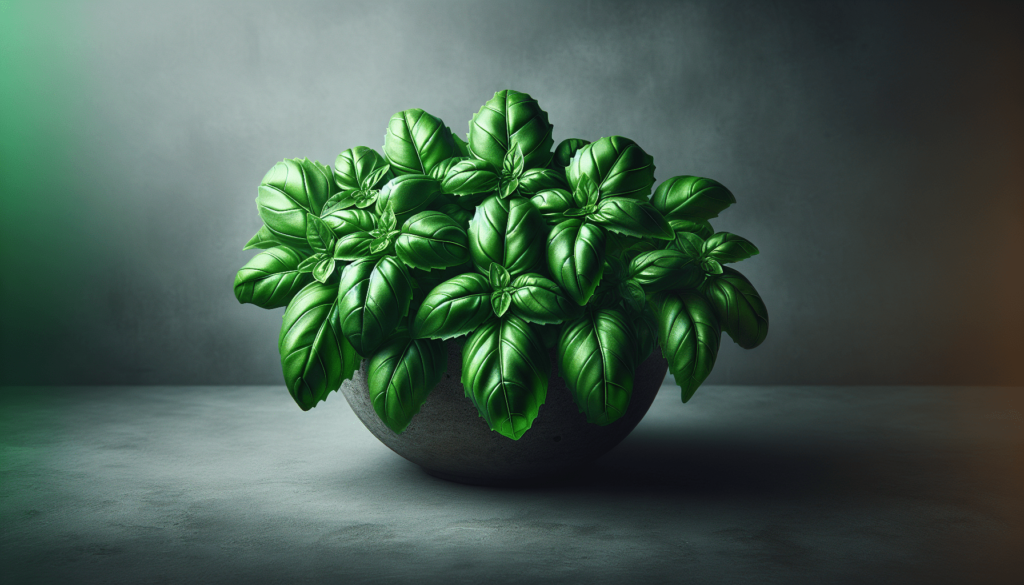So, you’ve always been curious about culinary herbs, huh? You know, those magical ingredients that can transform a bland dish into a burst of flavor? Well, you’re in luck because we’ve got the ultimate guide that will take you on a journey through the enchanting world of culinary herbs. From basil to thyme, we’ll introduce you to a variety of herbs that not only add a delicious twist to your cooking but also have a plethora of health benefits. Whether you’re a seasoned chef or a kitchen newbie, this guide will equip you with all the knowledge and know-how you need to elevate your culinary skills to the next level. Ready to dive in? Let’s go!
Introduction to Culinary Herbs
What are culinary herbs?
Culinary herbs are plants that are used for enhancing the flavor and aroma of various dishes in cooking. These herbs are typically leaves or leafy parts of plants and are known for their strong and distinctive flavors. They add depth and complexity to dishes, making them more enjoyable and delicious.
Benefits of using culinary herbs
Using culinary herbs in your cooking has several benefits. Firstly, they add flavor and depth to your dishes, making them more interesting and enjoyable to eat. These herbs also have various health benefits. Many culinary herbs are rich in antioxidants, which can help protect the body against free radicals and reduce the risk of chronic diseases. Additionally, herbs can aid digestion, reduce inflammation, and boost the immune system. Incorporating culinary herbs into your cooking can also be a cost-effective way to add flavor, as they can replace the need for excessive salt, sugar, or artificial flavorings.
Common culinary herbs
There are numerous culinary herbs that are commonly used in cooking. Some of the most popular ones include basil, rosemary, thyme, parsley, mint, oregano, cilantro, sage, chives, and dill. These herbs each have their own unique flavors and can be used in a variety of dishes to enhance the taste and aroma.
Growing Your Own Culinary Herbs
Choosing the right location
When it comes to growing your own culinary herbs, choosing the right location is crucial. Most herbs require ample sunlight to thrive, so it’s essential to select a spot in your garden or balcony that receives at least six to eight hours of direct sunlight each day. Additionally, consider the soil quality and drainage in the chosen area. Herbs generally prefer well-drained soil that is not too acidic or alkaline.
Preparing the soil
Before planting your culinary herbs, it’s important to prepare the soil properly. Start by removing any weeds or grass from the area and loosen the soil by tilling or digging. Add organic matter such as compost or well-rotted manure to improve the soil’s fertility and drainage. This will provide a healthy growing environment for your herbs and help them thrive.
Selecting herb varieties
There are many varieties of culinary herbs, each with its own flavor and culinary uses. When selecting herb varieties, consider what types of dishes you enjoy cooking and what flavors you’d like to incorporate into your meals. Popular varieties include sweet basil, lemon thyme, curly parsley, peppermint, Greek oregano, and Italian flat-leaf parsley. Research the different varieties available and choose those that best suit your preferences and garden conditions.
Planting and caring for culinary herbs
Once you’ve selected the herb varieties, it’s time to start planting. Most herbs are easy to grow from seeds or can be purchased as small plants from a nursery. Follow the instructions on the seed packet or plant tag for the specific planting depth and spacing. After planting, water the herbs thoroughly and keep the soil consistently moist but not waterlogged. Regularly check for pests or diseases and take appropriate measures to control them. Harvest the herbs frequently to encourage new growth and ensure optimum flavor.
Popular Culinary Herbs
Culinary herbs come in various flavors and aromas, each adding its unique touch to dishes. Here are some popular culinary herbs and how they can elevate your cooking experience:
Basil
Basil is known for its sweet and slightly spicy flavor, with hints of lemon and mint. It pairs well with tomatoes, making it a staple in Italian dishes like Caprese salad and pesto. Basil can also be used in other cuisines, such as Thai cuisine, where it adds a fresh and aromatic element to curries and stir-fries.
Rosemary
Rosemary has a savory and pine-like fragrance, with a slightly bitter taste. It is commonly used in Mediterranean cuisine, especially with roasted or grilled meats and vegetables. Rosemary can also enhance the flavor of bread, soups, and marinades, bringing a unique depth to these dishes.
Thyme
Thyme has a subtle, earthy flavor with hints of lemon and mint. It is a versatile herb that pairs well with a wide range of ingredients, such as poultry, fish, vegetables, and sauces. Thyme is often used in French cuisine, particularly in dishes like roasted chicken and stews.
Parsley
Parsley is a widely used herb known for its fresh and slightly peppery flavor. It is often used as a garnish to add color and freshness to dishes. Flat-leaf parsley, also known as Italian parsley, is preferred for its stronger flavor and is commonly used in Mediterranean and Middle Eastern cuisines.
Mint
Mint has a refreshing and cooling flavor, with a hint of sweetness. It is often used in both sweet and savory dishes, such as teas, salads, desserts, and cocktails. Mint is a key ingredient in dishes from various cuisines, including Middle Eastern, Indian, and Southeast Asian.
Oregano
Oregano has a robust and slightly bitter flavor, reminiscent of a combination of thyme and marjoram. It is commonly used in Italian and Greek cuisines, particularly in tomato-based dishes like pasta sauces and pizzas. Oregano can also enhance the flavor of roasted vegetables and grilled meats.
Cilantro
Cilantro, also known as coriander leaves, has a vibrant and citrusy flavor. It is commonly used in Mexican, Indian, and Southeast Asian cuisines. Cilantro is often added to salsas, curries, stir-fries, and salads, bringing a fresh and aromatic element to these dishes.
Sage
Sage has a strong and earthy flavor, with hints of mint and eucalyptus. It is commonly used in Mediterranean cuisine and pairs well with fatty meats like pork and duck. Sage can also be used in stuffing, soups, and sauces, adding a unique depth of flavor.
Chives
Chives have a mild and delicate onion flavor. They are often used as a garnish in salads, soups, and dips, providing a subtle hint of onion without overpowering the dish. Chives can also be used as a finishing touch on baked potatoes or as a flavor enhancer in egg dishes.
Dill
Dill has a distinct flavor with hints of anise and lemon. It is commonly used in pickling cucumbers, as well as in fish dishes, soups, and salads. Dill leaves and seeds can both be utilized in cooking, each providing a slightly different flavor profile.
Using Culinary Herbs in Cooking
Understanding flavor profiles
When using culinary herbs in your cooking, it’s essential to understand their flavor profiles and how they interact with other ingredients. Some herbs, like basil and cilantro, have a bright and fresh taste, while others, like rosemary and sage, have a more robust and earthy flavor. Experimenting with different combinations of herbs can help you create a well-balanced and harmonious dish.
Pairing herbs with different dishes
Different culinary herbs pair well with specific types of dishes. For example, basil is commonly used in Italian cuisine, while cilantro is frequently found in Mexican and Southeast Asian dishes. Consider the flavor profile of the herb and the cuisine you are cooking to select the most appropriate herb for the dish. For example, thyme and rosemary are excellent choices for roasted meats, while dill complements fish dishes beautifully.
Using fresh vs. dried herbs
Both fresh and dried herbs can be used in cooking, but they have slightly different flavors and strengths. Fresh herbs have a brighter and more vibrant taste, while dried herbs have a more concentrated and intense flavor. As a general rule, use three times the amount of fresh herbs compared to dried herbs when substituting one for the other in a recipe. However, it’s worth noting that some herbs, such as bay leaves and oregano, are often used in their dried form, as their flavors intensify when dried.
Techniques for incorporating herbs into recipes
There are various techniques for incorporating herbs into recipes, depending on your desired outcome. If you want the herb flavor to be infused throughout the dish, add the herbs during the cooking process. For a more pronounced and fresh flavor, add the herbs towards the end of the cooking time or use them as a garnish. You can also experiment with herb-infused oils, herb butter, or herb marinades to add an extra layer of flavor to your dishes.
Avoiding common mistakes when using herbs
When using culinary herbs in your cooking, there are a few common mistakes to avoid. Firstly, using too much or too little herb can significantly impact the flavor of a dish. Start with small amounts and gradually adjust to taste. It’s also important to use the appropriate herb in the right proportion for the dish, as not all herbs pair well with every ingredient. Lastly, be mindful of the cooking time for delicate herbs like cilantro and parsley, as overcooking them can diminish their flavor and vibrancy.
Preserving Culinary Herbs
Drying herbs
Drying herbs is a simple and effective way to preserve their flavors for future use. To dry herbs, gather a bunch of fresh herbs and tie them together with a string or secure them with a rubber band. Hang the herbs upside down in a cool, dry place with good airflow. Once the herbs are completely dry and crispy, remove the leaves from the stems and store them in an airtight container. Dried herbs can be used in cooking or to make herbal teas.
Freezing herbs
Freezing herbs is another great method to preserve their flavors. Wash and pat dry the herbs, removing any excess moisture. Chop the herbs finely and place them in ice cube trays, covering them with either water or olive oil. Once frozen, transfer the herb cubes into Ziploc bags or airtight containers and store them in the freezer. You can easily pop a herb cube into your cooking whenever you need to add some flavor to your dishes.
Making herb-infused oils and vinegars
Herb-infused oils and vinegars are a wonderful way to capture the essence of culinary herbs and use them in cooking. To make herb-infused oils, place fresh herbs in a clean glass jar and cover them with olive oil. Let the jar sit in a cool, dark place for a couple of weeks, allowing the flavors to infuse into the oil. Strain the oil before using it in dressings, marinades, or for drizzling over dishes. Similarly, herb-infused vinegars can be made by steeping herbs in vinegar for a few weeks and then straining the mixture for use in salad dressings or marinades.
Health Benefits of Culinary Herbs
Digestive benefits
Many culinary herbs have digestive benefits and can help ease various digestive issues. For example, mint and ginger are known for their soothing properties and can help relieve indigestion and nausea. Fennel and dill can aid in digestion and alleviate symptoms like bloating and gas. Including these herbs in your meals can promote a healthy digestive system and support overall gut health.
Anti-inflammatory properties
Several culinary herbs possess anti-inflammatory properties, which can be beneficial for reducing inflammation in the body. Herbs like turmeric, ginger, and rosemary have natural anti-inflammatory compounds that can help alleviate symptoms of conditions like arthritis and inflammatory bowel diseases. Adding these herbs to your meals regularly can contribute to a healthier inflammatory response in the body.
Rich in antioxidants
Culinary herbs are often rich in antioxidants, which play a crucial role in protecting the body against damage from harmful free radicals. Antioxidants help neutralize free radicals and prevent oxidative stress, which has been linked to various chronic diseases and premature aging. Herbs like oregano, thyme, and basil are particularly high in antioxidants and can be a valuable addition to a healthy diet.
Immune-boosting effects
Certain culinary herbs possess immune-boosting properties that can help strengthen the body’s defense against infections and diseases. Herbs like garlic, oregano, and echinacea have antimicrobial and antiviral properties, while others like rosemary and thyme contain compounds that can stimulate the immune system. Incorporating these herbs into your cooking can contribute to a robust and resilient immune system.
Improving overall well-being
Aside from their specific health benefits, culinary herbs can contribute to overall well-being by enhancing the flavor and enjoyment of food. Good nutrition and enjoyment of meals play a vital role in maintaining a healthy lifestyle and positive mental well-being. The simple act of growing, cooking, and savoring dishes with fresh herbs can bring a sense of satisfaction and contentment.
Herbal Tea and Infusions
Popular herbal tea varieties
Herbal teas, also known as tisanes, offer a range of flavors and health benefits. Some popular herbal tea varieties include chamomile, peppermint, ginger, hibiscus, and lavender. Each herbal tea has its own unique flavor and potential health benefits, making them a popular choice for tea lovers.
Making herbal infusions
To make herbal infusions, simply steep the desired herb in hot water for a few minutes, allowing the flavors and properties to infuse into the water. The steeping time can vary depending on the herb and personal preference. Herbal infusions can be enjoyed hot or cold, and sweeteners like honey or stevia can be added to taste. Experiment with different herbs and blends to find your favorite herbal infusion combinations.
Benefits of herbal tea for health
Herbal teas offer various health benefits, depending on the herbs used. Chamomile tea is known for its calming and sleep-inducing properties, making it an excellent choice for relaxation and stress relief. Peppermint tea can aid digestion and soothe an upset stomach. Ginger tea is often used for its anti-inflammatory and immune-boosting effects. Hibiscus tea is rich in antioxidants and may help lower blood pressure. Lavender tea can promote relaxation and improve sleep quality. Incorporating herbal teas into your daily routine can support overall well-being and provide a comforting and flavorful experience.
Herbs for Natural Remedies
Herbs for digestion
Many culinary herbs have been used for centuries as natural remedies for digestive issues. Ginger, chamomile, and peppermint are particularly well-known for their beneficial effects on digestion. Ginger can alleviate nausea and promote healthy digestion. Chamomile has anti-inflammatory and calming properties that can help soothe an upset stomach. Peppermint has muscle-relaxing properties that can aid digestion and alleviate symptoms like bloating and indigestion.
Herbs for relaxation and sleep
Certain herbs have relaxing and sedative properties that can promote relaxation and improve sleep quality. Chamomile is one of the most popular herbs for relaxation and is often used to make soothing teas or herbal tinctures. Lavender is another herb known for its calming effects and can be used in teas, aromatherapy, or infused oils. Valerian root is a powerful herb that can help with sleep disorders and insomnia. These herbs can be used individually or in combination to create herbal remedies for relaxation and better sleep.
Herbs for cold and flu symptoms
Several culinary herbs have been traditionally used to alleviate symptoms of cold and flu. Echinacea, elderflower, and ginger are commonly used for their immune-boosting and antiviral properties. Thyme and eucalyptus have natural expectorant properties and can help ease congestion and coughs. Peppermint can help soothe sore throats and provide relief from coughing. Incorporating these herbs into your natural remedies can provide comfort and relief from cold and flu symptoms.
Herbs for skin care
Culinary herbs can be beneficial not only in cooking but also for skin care. Many herbs contain natural compounds that can help improve the health and appearance of the skin. Calendula has soothing and anti-inflammatory properties that can benefit sensitive or irritated skin. Rosemary has antioxidant properties that can help protect the skin against damage from free radicals. Lavender has antimicrobial properties and can be used to treat acne and other skin conditions. Homemade herbal skincare products, such as herbal-infused oils or facial steams, can be made using these herbs to harness their benefits for the skin.
Exploring Ethnic Cuisines and Culinary Herbs
Herbs in Italian cuisine
Italian cuisine is known for its abundant use of culinary herbs. Basil, oregano, rosemary, and thyme are commonly found in Italian recipes, adding depth and flavor to dishes like pasta sauces, pizzas, and roasted meats. Italian dishes often showcase the flavors of these herbs in a simple and elegant way, allowing them to shine and elevate the overall dining experience.
Herbs in Thai cuisine
Thai cuisine is famous for its vibrant and aromatic flavors, and herbs play a crucial role in achieving these tastes. Thai basil, lemongrass, cilantro, and kaffir lime leaves are frequently used in Thai dishes, adding a fresh and aromatic element. These herbs provide a unique balance of sweet, sour, salty, and spicy flavors, creating the distinct taste that Thai cuisine is renowned for.
Herbs in Mexican cuisine
Mexican cuisine heavily relies on the use of herbs to create bold and flavorful dishes. Cilantro, oregano, and epazote are commonly used in Mexican recipes, adding a fresh and herbal taste to salsas, guacamole, tacos, and enchiladas. The combination of spices and herbs in Mexican cuisine contributes to its rich and vibrant flavor profile.
Herbs in Indian cuisine
Indian cuisine is known for its complex and aromatic flavors, achieved through the use of various culinary herbs and spices. Coriander leaves, mint, fenugreek, and curry leaves are commonly used herbs in Indian cooking, adding freshness and depth to dishes. These herbs are often incorporated into curries, chutneys, and rice dishes, infusing them with their unique flavors and aromas.
Gardening Tips for Culinary Herbs
Companion planting
Companion planting is a gardening technique where certain plants are grown together to benefit each other. Some herbs, like basil and rosemary, have natural pest-repellent properties and can help protect other plants from insect damage. For example, planting basil near tomato plants can deter pests like aphids and tomato hornworms. Companion planting can also help maximize space and improve pollination in the garden.
Controlling pests and diseases in herb gardens
Preventing and controlling pests and diseases is essential for maintaining healthy herb gardens. Regularly inspect the plants for signs of pests like aphids, snails, or whiteflies. Introduce natural predators like ladybugs or use organic pest control methods, such as neem oil or insecticidal soap, to deter pests. Proper watering and good air circulation can help prevent diseases like powdery mildew or root rot. If diseases occur, remove and destroy affected plants or use appropriate organic treatments.
Harvesting herbs for cooking
Harvesting the herbs properly is crucial for maintaining their flavor and promoting new growth. Most herbs can be harvested as soon as they reach a reasonable size. To harvest, simply snip the leaves or stems from the plant using clean and sharp scissors or shears. It’s advisable to harvest in the morning when the herbs are at their peak in terms of flavor and fragrance. Regularly harvesting herbs will encourage bushier growth and ensure a continuous supply for your culinary endeavors.
Creating a beautiful herb garden
In addition to their culinary benefits, herbs can also add beauty and visual interest to your garden. Consider creating a dedicated herb garden bed or interplanting herbs among other flowers and vegetables for an aesthetically pleasing and functional garden. Incorporating different-colored herbs and utilizing various heights and textures can create a visually appealing herb garden that provides both practical and ornamental value.
By understanding the different aspects of culinary herbs, from growing and cooking with them to their health benefits and cultural significance, you can fully appreciate and utilize these incredible plants in your daily life. Whether it’s enhancing the flavor of your favorite dishes, creating natural remedies, or simply enjoying a cup of herbal tea, culinary herbs offer a world of possibilities for both culinary enthusiasts and those seeking a healthier and more holistic lifestyle. So start exploring the diverse world of culinary herbs and unlock a wealth of flavors and benefits that will elevate your culinary adventures.






